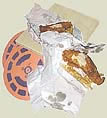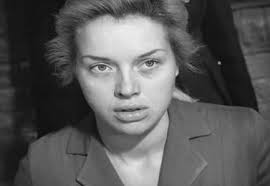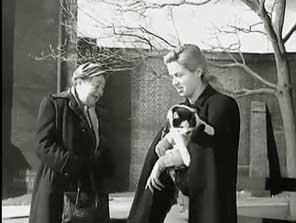

 FRIDAY FILM AND FISH & CHIP SHOW !
FRIDAY FILM AND FISH & CHIP SHOW !'YIELD TO THE NIGHT' (1956) Friday 3rd April, 2015
 Diana Dors as the condemned murderess in 'Yield to the Night'
Diana Dors as the condemned murderess in 'Yield to the Night'
This Good Friday the theme is a trial and execution.
Diana Dors' graphic performance as a young woman undergoing the ordeal of the condemned cell in Holloway is more poignant in that her friend Ruth Ellis had been executed the year previously.
Ruth Neilson had worked as a nightclub hostess at the Court Club in Mayfair, where she had become a close friend of Diana Dors. Ruth, aged 24, had married 41 year old divorced dentist and Court Club regular George Ellis in 1950. He was a violent gealous alcoholic. She left him several times but eventually came back. In 1951, while four months pregnant, Ellis appeared uncredited in the Diana Dors film 'Lady Godiva Rides Again.' When the child was born George denied paternity and they separated. By 1953 she was managing a nightclub popular with racing drivers. Mike Hawthorn introduced her to David Blakely, a young racing driver who had just had a try-out for the Le Mans 24 hour race. Shortly after, Blakely moved in with Ellis who had a flat above the club. The relationship became violent and embittered. Blakely proposed marriage and she agreed. Later, Ellis miscarried when Blakely had punched her in the stomach.
On Easter Sunday 1955, Ruth Ellis shot David Blakely with a revolver outside the Magdala pub in South Hill Park near Hampstead Heath.
The plotline and murder in flashback within the film is not the same as the Ruth Ellis case, but from the 1954 novel by Joan Henry. However the shooting by revolver in the street in the film is made to be similar.
The cinematography of Gilbert Taylor is exceptional with the heightened details of the condemned cell and he again shows patience with a cat - the same one in the window in 'The Yellow Balloon.'
 Athene Seyler, Diana Dors, and that cat from 'THE YELLOW BALLOON'
Athene Seyler, Diana Dors, and that cat from 'THE YELLOW BALLOON'
Gilbert Taylor uses below-the-knee shots and 'Dutch tilts' for the opening sequence so that the mundane street view is shown, from a different perspective. This prepares for the unexpected shooting. Director J Lee Thompson does not show a vengeful protagonist in the opening scenes and the motivation is covered by flashbacks within the film. The flashbacks concerning the jilted poets' suicide are derived from the novel and appear very dated, while the prison sequences are real and contemporary making it difficult to believe the film was made as early as 1956.
Diana Dors' performance
The film plays without any sudden religious conversion or profession of regret for her crime which makes Diana Dors work so credible and moving. The instances of the anticipation of reprieve when the Governess thoughtlessly appears with a paper and the progression of last days is unnerving. The way that the stress on the prison staff is dealt with too makes an exceptional film. The part played by Yvonne Mitchell of the prison officer bonding with the condemned woman also excells.
At the beginning of the print is a title caption mentioning that abolition of the death penalty was being debated in the House of Lords indicating a reissue of the film in 1965 to coincide with the debate. Printed on Gaevart film stock, it is an original 16mm print with sharp detail and excellent contrast.
Back to Friday Film & Fish & Chip Shows
About | Privacy/Terms | Contact | FAQ
www.ian-partridge.com ~ Web page content photography and design ~ Copyright © 2015 ~ 2025 Ian Partridge.